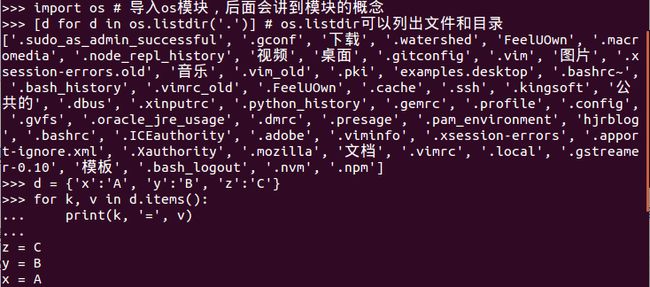Python教程学习简记5--Python 列表生成式(List Comprehensions)
列表生成式即List Comprehensions,是Python内置的非常简单却强大的可以用来创建list的生成式。
举个例子,要生成list [1,2,3,4,5,6,7,8,9,10]可以用list(range(1, 11)):
>>> list(range(1, 11))
[1, 2, 3, 4, 5, 6, 7, 8, 9, 10]但是如果要生成[1*1, 2*2 ,3*3, …, 10*10]怎么做?
方法一是循环:
>>> L = []
>>> for x in range(1,11):
... L.append(x * x)
...
>>> L
[1, 4, 9, 16, 25, 36, 49, 64, 81, 100]但是循环太繁琐,而列表生成器则可以用一行语句代替循环生成上面的list:
>>> [x * x for x in range(1, 11)]
[1, 4, 9, 16, 25, 36, 49, 64, 81, 100]写列表生成式时,把要生成元素x * x放在前面,后面跟for循环,就可以把list创建出来,十分有用,多谢几次,很快就可以熟悉这种写法。
for循环后面还可以加上if判断,这样我们就可以筛选出仅偶数的平方:
>>> [x * x for x in range(1, 11) if x % 2 == 0]
[4, 16, 36, 64, 100]还可以使用两层循环,可以生成全排列:
>>> [m + n for m in 'ABC' for n in 'XYZ']
['AX', 'AY', 'AZ', 'BX', 'BY', 'BZ', 'CX', 'CY', 'CZ']运用列表生成式,可以写出非常简洁的代码。例如,列出当前目录下的所有文件和目录名,可以通过一行代码实现:
>>> import os # 导入os模块,后面会讲到模块的概念
>>> [d for d in os.listdir('.')] # os.listdir可以列出文件和目录
['.sudo_as_admin_successful', '.gconf', '下载', '.watershed', 'FeelUOwn', '.macromedia', '.node_repl_history', '视频', '桌面', '.gitconfig', '.vim', '图片', '.xsession-errors.old', '音乐', '.vim_old', '.pki', 'examples.desktop', '.bashrc~', '.bash_history', '.vimrc_old', '.FeelUOwn', '.cache', '.ssh', '.kingsoft', '公共的', '.dbus', '.xinputrc', '.python_history', '.gemrc', '.profile', '.config', '.gvfs', '.oracle_jre_usage', '.dmrc', '.presage', '.pam_environment', 'hjrblog', '.bashrc', '.ICEauthority', '.adobe', '.viminfo', '.xsession-errors', '.apport-ignore.xml', '.Xauthority', '.mozilla', '文档', '.vimrc', '.local', '.gstreamer-0.10', '模板', '.bash_logout', '.nvm', '.npm']for循环其实可以同时使用两个甚至多个变量,比如dict的items()可以同时迭代key和value:
>>> d = {'x':'A', 'y':'B', 'z':'C'}
>>> for k, v in d.items():
... print(k, '=', v)
...
z = C
y = B
x = A因此,列表生成式也可以使用两个变量来生成list:
>>> d = {'x':'A', 'y':'B', 'z':'C'}
>>> [k + '=' + v for k, v in d.items()]
['z=C', 'y=B', 'x=A']最后把一个list中所有的字符串变成小写:
>>> L = ['Hello', 'World', 'IBM', 'Apple']
>>> [s.lower() for s in L]
['hello', 'world', 'ibm', 'apple']小练习:
如果list中既包含字符串,又包含整数,由于非字符串类型没有lower()方法,所以列表生成式就会报错:
>>> L = ['Hello', 'World', 18, 'Apple', 'None']
>>> [s.lower() for s in L]
Traceback (most recent call last):
File "<stdin>", line 1, in <module>
File "<stdin>", line 1, in <listcomp>
AttributeError: 'int' object has no attribute 'lower'使用内建的isinstance函数可以判断一个变量是不是字符串:
>>> x = 'abc'
>>> y = 123
>>> isinstance(x, str)
True
>>> isinstance(y, str)
False请修改列表生成式,通过添加if语句保证列表生成式能正确地执行:
>>> L1 = ['Hello', 'World', 18, 'Apple', 'None']
>>> [s.lower() for s in L1]
Traceback (most recent call last):
File "<stdin>", line 1, in <module>
File "<stdin>", line 1, in <listcomp>
AttributeError: 'int' object has no attribute 'lower'
>>> L2 = [s.lower() for s in L1 if isinstance(s, str)]
>>> L2
['hello', 'world', 'apple', 'none']


